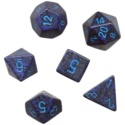
Dungeons & Dragons is a fantasy tabletop role-playing game (RPG) originally designed by Gary Gygax and Dave Arneson. The game was first published in 1974 by Tactical Studies Rules, Inc. (TSR). It has been published by Wizards of the Coast since 1997. The game was derived from miniature wargames, with a variation of the 1971 game Chainmail serving as the initial rule system. D&D's publication is commonly recognized as the beginning of modern role-playing games and the role-playing game industry, and also deeply influenced video games, especially the role-playing video game genre.
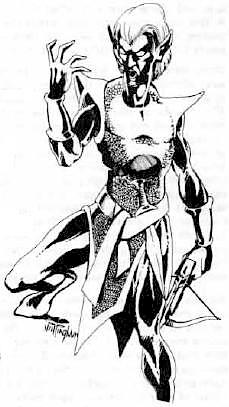
The drow or dark elves are a dark-skinned and white-haired subrace of elves connected to the subterranean Underdark in the Dungeons & Dragons fantasy roleplaying game. The drow have traditionally been portrayed as generally evil and connected to the evil goddess Lolth. However, later editions of Dungeons & Dragons have moved away from this portrayal and preassigned alignment. More recent publications have explored drow societies unconnected to Lolth.
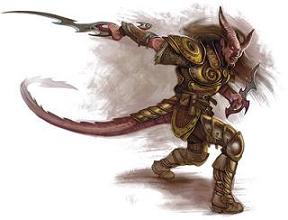
The tiefling is a fictional humanoid race in the Dungeons & Dragons (D&D) fantasy roleplaying game. Originally introduced in the Planescape campaign setting in the second edition of Advanced Dungeons & Dragons as a player character race for the setting, they became one of the primary races available for player characters in the fourth edition of the game.
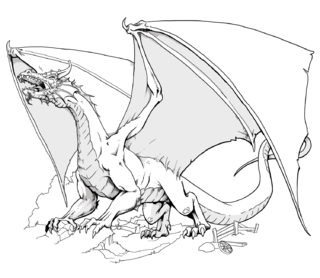
In the Dungeons & Dragons (D&D) fantasy role-playing game, dragons are an iconic type of monstrous creature. As a group, D&D dragons are loosely based on dragons from a wide range of fictional and mythological sources. Dungeons & Dragons allows players to fight the fictional dragons in the game and "slay their psychic dragons" as well. These dragons, specifically their "dungeon ecology", have implications for the literary theory of fantasy writing. D&D dragons also featured as targets of the moral panic surrounding the game.
In the fantasy role-playing game Dungeons & Dragons, an Outer Plane is one of a number of general types of planes of existence. They can also be referred to as godly planes, spiritual planes or divine planes. The Outer Planes are home to beings such as deities and their servants such as demons, celestials and devils. Each Outer Plane is usually the physical manifestation of a particular moral and ethical alignment and the entities that dwell there often embody the traits related to that alignment.

Ravenloft is an adventure module for the Dungeons & Dragons (D&D) fantasy role-playing game. The American game publishing company TSR, Inc. released it as a standalone adventure booklet in 1983 for use with the first edition Advanced Dungeons & Dragons game. It was written by Tracy and Laura Hickman, and includes art by Clyde Caldwell with maps by David Sutherland III. The plot of Ravenloft focuses on the villain Strahd von Zarovich, a vampire who pines for his lost love. Various story elements, including Strahd's motivation and the locations of magical weapons, are randomly determined by drawing cards. The player characters attempt to defeat Strahd and, if successful, the adventure ends.
In the Dungeons & Dragons (D&D) fantasy role-playing game, alignment is a categorization of the ethical and moral perspective of player characters, non-player characters, and creatures.
The druid is a playable character class in the Dungeons & Dragons fantasy role-playing game. Druids wield nature-themed magic. Unlike clerics, druids do not have special powers against undead and, in some editions, cannot use metal armor. Druids have a unique ability that allows them to change into various animal forms, and various other qualities that assist them in natural settings.

Dragonlance Adventures is a 128-page hardcover book for the Dragonlance campaign setting for the first edition of the Advanced Dungeons & Dragons fantasy role-playing game.
Several different editions of the Dungeons & Dragons (D&D) fantasy role-playing game have been produced since 1974. The current publisher of D&D, Wizards of the Coast, produces new materials only for the most current edition of the game. However, many D&D fans continue to play older versions of the game and some third-party companies continue to publish materials compatible with these older editions.
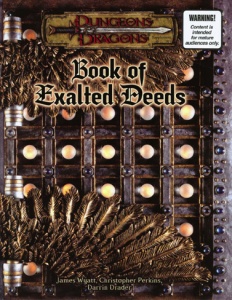
The Book of Exalted Deeds is an optional sourcebook for the 3.5 edition of the Dungeons & Dragons role-playing game published by Wizards of the Coast (WotC) in 2003. It provides supplementary game material for campaigns involving characters of good alignment. Within the game, there is also a powerful magical artifact of the same name.
The paladin is one of the standard playable character classes in most editions of the Dungeons & Dragons fantasy role-playing game. The paladin is a holy knight, crusading in the name of good and order, and is a divine spellcaster.
The cleric is one of the standard playable character class in the Dungeons & Dragons fantasy role-playing game. Clerics are versatile figures, both capable in combat and skilled in the use of divine magic (thaumaturgy). Clerics are powerful healers due to the large number of healing and curative magics available to them. With divinely-granted abilities over life or death, they are also able to repel or control undead creatures. Clerics also have specific 'domains' which usually align with the character's alignment and the god that cleric serves. Whether the cleric repels or controls undead is dependent on the cleric's alignment. It is the only class to be included in every edition of Dungeons & Dragons without a name change.

An attribute is a piece of data that describes to what extent a fictional character in a role-playing game possesses a specific natural, in-born characteristic common to all characters in the game. That piece of data is usually an abstract number or, in some cases, a set of dice. Some games use different terms to refer to an attribute, such as statistic, (primary) characteristic or ability. A number of role-playing games like Fate do not use attributes at all.

Character creation is the process of defining a player character in a role-playing game. The result of character creation is a direct characterization that is recorded on a character sheet. This may include a representation of the character's physical, mental, psychological, and social attributes and skills in terms of the specific game's mechanics. It may also include informal descriptions of the character's physical appearance, personality, personal back-story ("background"), and possessions. Games with a fantasy setting may include traits such as race, class, or species. Character creation is the first step taken by the players in preparation for a game.
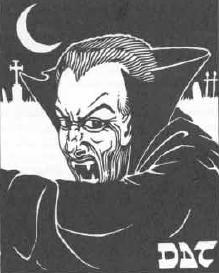
In the Dungeons & Dragons fantasy role-playing game, a vampire is an undead creature. A humanoid or monstrous humanoid creature can become a vampire, and looks as it did in life, with pale skin, haunting red eyes, and a feral cast to its features. A new vampire is created when another vampire drains the life out of a living creature. Its depiction is related to those in the 1930s and 1940s Hollywood Dracula and monster movies. In writing vampires into the game, as with other creatures arising in folklore, the authors had to consider what elements arising in more recent popular culture should be incorporated into their description and characteristics.
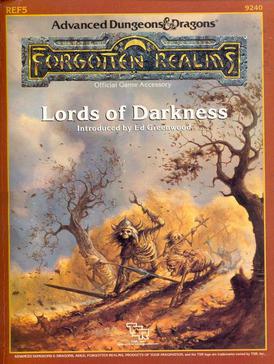
Lords of Darkness is the name of two accessories for the fictional Forgotten Realms campaign setting for the Dungeons & Dragons fantasy role-playing game.

A tabletop role-playing game, also known as a pen-and-paper role-playing game, is a classification for a role-playing game (RPG) in which the participants describe their characters' actions through speech. Participants determine the actions of their characters based on their characterization, and the actions succeed or fail according to a set formal system of rules and guidelines. Within the rules, players have the freedom to improvise; their choices shape the direction and outcome of the game.

Character race is a descriptor used to describe the various sapient species and beings that make up the setting in modern fantasy and science fiction. In many tabletop role-playing games and video games, players may choose to be one of these creatures when creating their player character (PC) or encounter them as a non-player character (NPC). "People" is to be taken in the broader sense, and may encompass ethnic groups, species, nationality or social groups.
